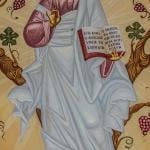MOTHER CATHERINE SETON, NEW YORK, SERVANT OF PRISONERS
Mother Catherine Seton was the youngest daughter of the saintly Elizabeth Seton, the Foundress of the Sisters of Charity in the United States. Strange to say, she had no attraction for her venerated mother’s order, and when at length she decided on carrying out her religious vocation, she appealed to Archbishop Hughes to direct her choice. He had just completed arrangements for bringing the Sisters of Mercy to New York and advised her to wait their arrival.
She did so, and fascinated with the description of the works of Mercy given her by Mother Agnes O’Connor, she entered in West Washington Place on the 11th of October, 1846, being the first choir postulant admitted to the new community.
Before the Sisters were ten months in the city, the Commissioners of Charity offered them free access to the prisons and hospitals. Here, Mother Catherine found her true vocation, and the visiting of the Tombs and Sing Sing was thoroughly organized by her at that remote period. Having spent many years abroad, she was thoroughly conversant with the French and Italian languages. As soon as she began the visitation of the Tombs, she set herself the task of learning German and Spanish, in order that her usefulness among the unhappy inmates might find no limit. She rejoiced in the title of the “Prison Sisters” and had a motherly way of speaking of the prisoners.
She certainly worked wonders among them and kept up her labor of love with advancing years until compelled to resign the actual work to younger though not less willing hands. Till the time of her last illness she held a general supervision over this cherished duty, and it was a matter of course for the Sisters who had visited the prison to turn into Mother Catherine’s room at evening recreation and give her an account of the day.
Some very laughable events occurred in her prison career. She was once sent a trunk from Philadelphia, supposed to contain books or clothing donated for the poor. Considerable curiosity was shown by the Sisters regarding its opening, and genuine fun prevailed in the community when its lock was forced, and pistols, “jimmies,” and a choice variety of burglar’s tools were displayed to the astonished beholders. She made a shrewd guess at the sender, and not long afterward heard of his death. No doubt, he thought the convent the safest place for his strange legacy. On the occasion of Mother Catherine’s Silver Jubilee, April 17, 1874, she was presented with several suits of men’s clothing in the pockets of which twenty-five dollars in silver were deftly concealed. The gift of the prisoners was most gratefully received.
Kathleen Healy, R.S.M., ed., Sisters of Mercy: Spirituality in America, 1843-1900 (New York: Paulist Press, 1992), 247-248.










